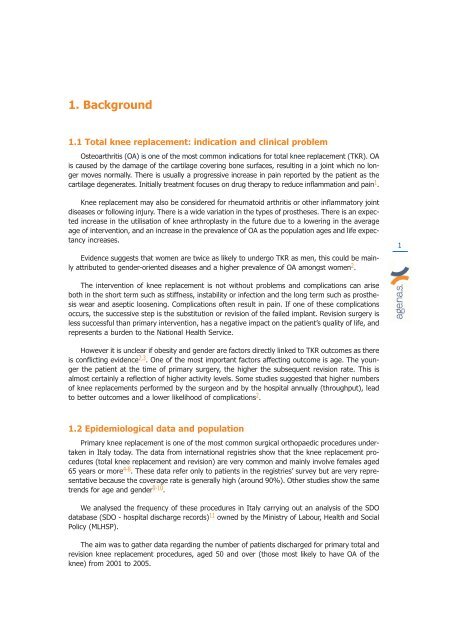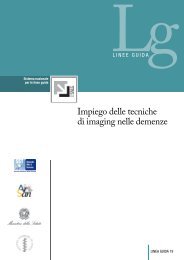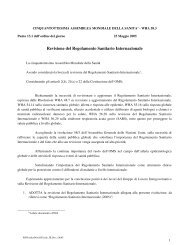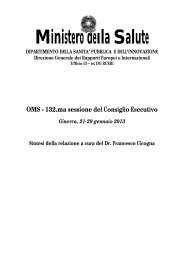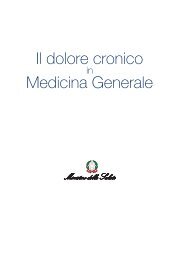hta_ knee intro.qxp - Ministero della Salute
hta_ knee intro.qxp - Ministero della Salute
hta_ knee intro.qxp - Ministero della Salute
Create successful ePaper yourself
Turn your PDF publications into a flip-book with our unique Google optimized e-Paper software.
1. Background<br />
1.1 Total <strong>knee</strong> replacement: indication and clinical problem<br />
Osteoarthritis (OA) is one of the most common indications for total <strong>knee</strong> replacement (TKR). OA<br />
is caused by the damage of the cartilage covering bone surfaces, resulting in a joint which no longer<br />
moves normally. There is usually a progressive increase in pain reported by the patient as the<br />
cartilage degenerates. Initially treatment focuses on drug therapy to reduce inflammation and pain 1 .<br />
Knee replacement may also be considered for rheumatoid arthritis or other inflammatory joint<br />
diseases or following injury. There is a wide variation in the types of prostheses. There is an expected<br />
increase in the utilisation of <strong>knee</strong> arthroplasty in the future due to a lowering in the average<br />
age of intervention, and an increase in the prevalence of OA as the population ages and life expectancy<br />
increases.<br />
Evidence suggests that women are twice as likely to undergo TKR as men, this could be mainly<br />
attributed to gender-oriented diseases and a higher prevalence of OA amongst women 2 .<br />
The intervention of <strong>knee</strong> replacement is not without problems and complications can arise<br />
both in the short term such as stiffness, instability or infection and the long term such as prosthesis<br />
wear and aseptic loosening. Complications often result in pain. If one of these complications<br />
occurs, the successive step is the substitution or revision of the failed implant. Revision surgery is<br />
less successful than primary intervention, has a negative impact on the patient’s quality of life, and<br />
represents a burden to the National Health Service.<br />
However it is unclear if obesity and gender are factors directly linked to TKR outcomes as there<br />
is conflicting evidence 2,3 . One of the most important factors affecting outcome is age. The younger<br />
the patient at the time of primary surgery, the higher the subsequent revision rate. This is<br />
almost certainly a reflection of higher activity levels. Some studies suggested that higher numbers<br />
of <strong>knee</strong> replacements performed by the surgeon and by the hospital annually (throughput), lead<br />
to better outcomes and a lower likelihood of complications 2 .<br />
1.2 Epidemiological data and population<br />
Primary <strong>knee</strong> replacement is one of the most common surgical orthopaedic procedures undertaken<br />
in Italy today. The data from international registries show that the <strong>knee</strong> replacement procedures<br />
(total <strong>knee</strong> replacement and revision) are very common and mainly involve females aged<br />
65 years or more 4-8 . These data refer only to patients in the registries’ survey but are very representative<br />
because the coverage rate is generally high (around 90%). Other studies show the same<br />
trends for age and gender 9-10 .<br />
We analysed the frequency of these procedures in Italy carrying out an analysis of the SDO<br />
database (SDO - hospital discharge records) 11 owned by the Ministry of Labour, Health and Social<br />
Policy (MLHSP).<br />
The aim was to gather data regarding the number of patients discharged for primary total and<br />
revision <strong>knee</strong> replacement procedures, aged 50 and over (those most likely to have OA of the<br />
<strong>knee</strong>) from 2001 to 2005.<br />
1


